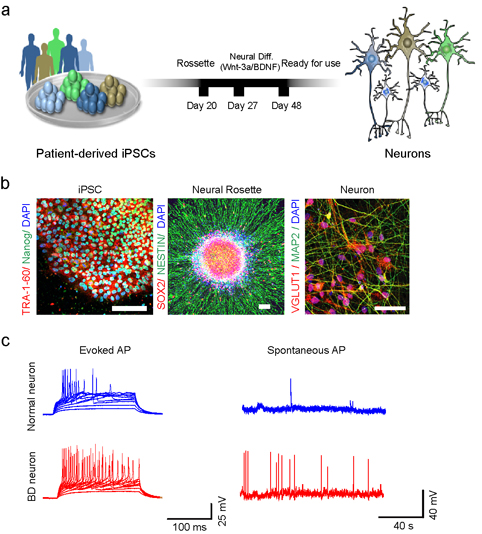Professor Yao's Group Reported Latest Progress in Studying the Pathogenesis of Bipolar Disorder (BD) based on Induced Pluripotent Stem Cell (iPSC) Technology
On October 28th, 2015, the Yao lab’s manuscript, entitled ‘Differential responses to lithium in hyperexcitable neurons from patients with bipolar disorder’, was published online in Nature. In this paper, the authors reported their latest progress in studying the pathogenesis of Bipolar disorder (BD) based on the induced pluripotent stem cell (iPSC) technology.

Figure. Hyperexcitability in hippocampal neurons derived from iPSCs of bipolar disorder patients. a, Diagram showing the differentiation of hippocampal DG-like neurons from BD patient iPSCs. b, Representative immunostaining images of iPSCs, neural rosettes and neurons. c, Sample traces of current injection-evoked (left) or spontaneous (right) action potentials (APs). BD neurons exhibited hyperexcitability compared to normal neurons.
BD is a complex neuropsychiatric disorder that is characterized by intermittent episodes of mania and depression; without treatment, 15% of patients commit suicide. Hence, BD has been ranked by the WHO as a top disorder of morbidity and lost productivity. Previous neuropathological studies have revealed a series of alterations in the brains of BD patients or animal models, such as reduced glial cell number in the patient prefrontal cortex, up-regulated activities of the PKA/PKC pathways, and changes in neurotransmission. However, the roles and causation of these changes in BD have been too complex to exactly determine the pathology of the disease. Furthermore, while some patients show remarkable improvement with lithium treatment, for yet unknown reasons, other patients are refractory to lithium treatment. Therefore, developing an accurate and powerful biological model for BD has been a challenge. The introduction of induced pluripotent stem cell (iPSC) technology has provided a new approach. Here, we developed a human BD iPSC model and investigated the cellular phenotypes of hippocampal dentate gyrus-like neurons derived from patient iPSCs. Guided by RNA-seq expression profiling, we detected mitochondrial abnormalities in young BD neurons using mitochondrial assays and, using both patch clamp recording and somatic Ca2+ imaging, we observed hyperactive action potential (AP) firing. This hyperexcitability phenotype of young BD neurons was selectively reversed by lithium treatment only in neurons derived from the patients who also responded to lithium treatment. Therefore, hyperexcitability is one early endophenotype of BD, and our BD iPSC model may be useful for the development of new therapies and drugs aimed at clinical treatment of this disease.
Dr. Jun Yao from the School of Life Sciences, Tsinghua University, Dr. Fred Gage from the Salk Institute for Biological Studies, USA, and Dr. John Kelsoe from University of California, San Diego, USA, are co-corresponding authors of the paper. Jerome Mertens and Qiu-Wen Wang are co-first authors. All other co-authors made significant contributions to the paper.

